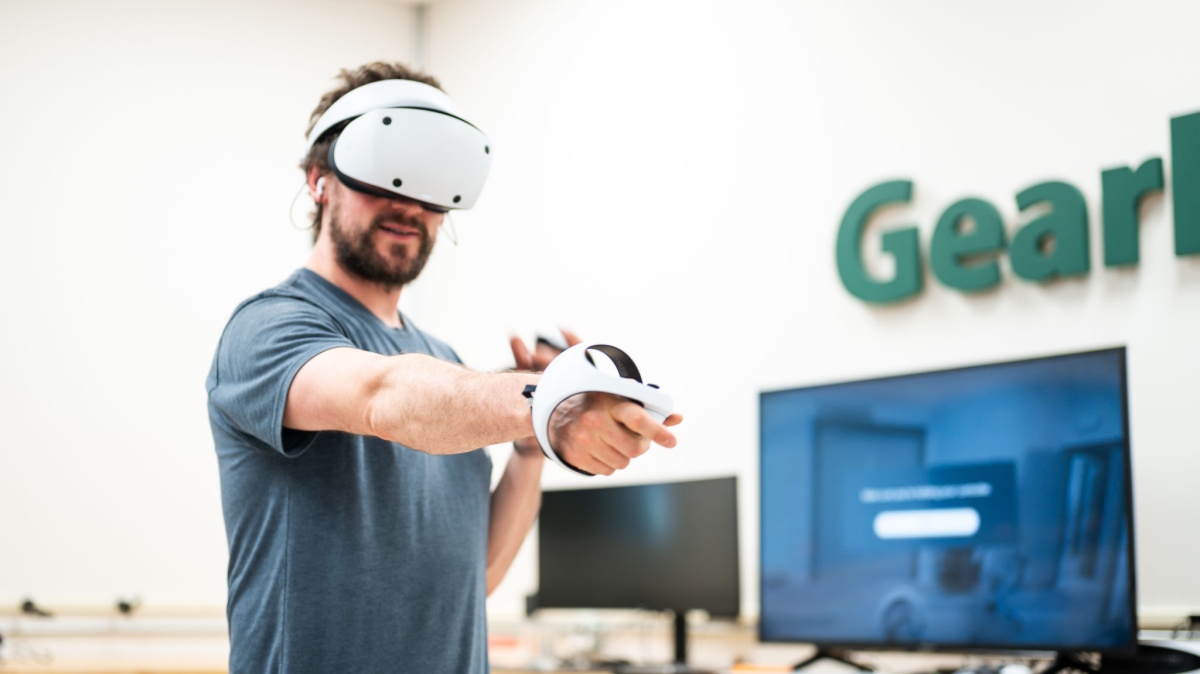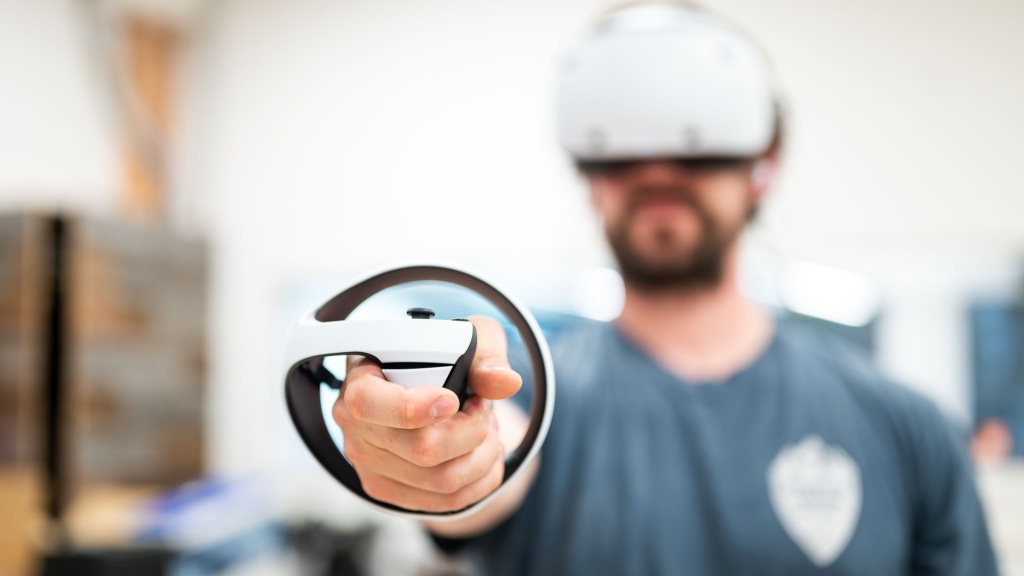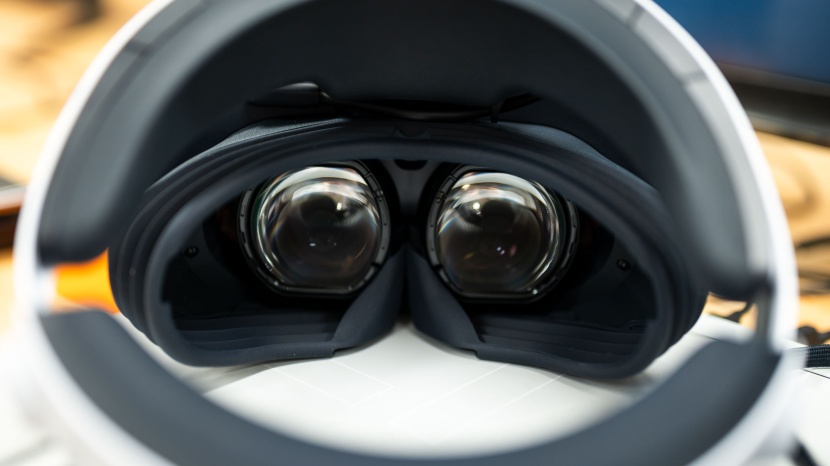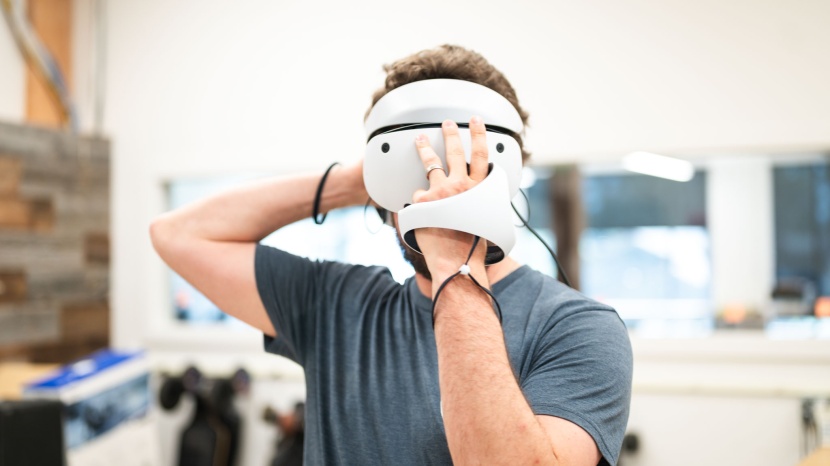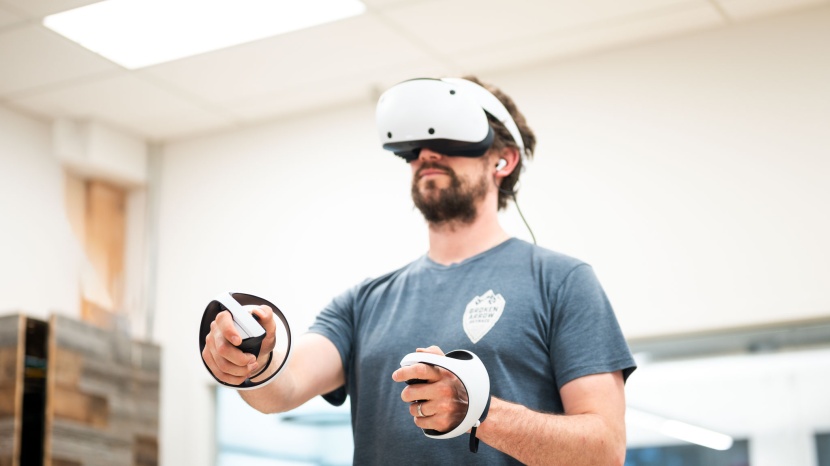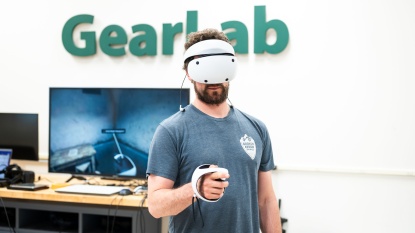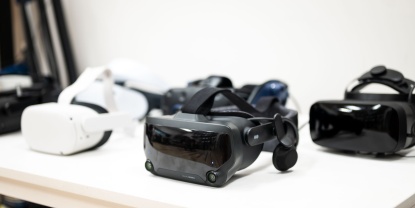
Our Verdict
Our Analysis and Test Results
The Sony Playstation VR2 takes over for the original PSVR, expanding on the streamlined experience and optimized content with higher resolution visuals, improved performance, and advanced eye-tracking.
Tracking
The Sony PlayStation VR2 has some excellent tracking, especially considering that it uses camera-based sensors built into the headset. While it still falls short of the flawless precision we've gotten from kits with sensor units, it reigns supreme among the built-in camera-based systems. It even features eye-tracking, which few other headsets provide.
One game common across all the VR platforms we've tested on is Beat Saber, and as a fast-paced rhythm-based game, it makes for an excellent test for motion-tracking. The PlayStation VR2's tracking in Beat Saber was phenomenal. The headset and Sense Controllers were able to pick up everything we threw down, even connecting with far-away notes in the 360-degree songs that would trip up other camera-based sensor setups, like the Reverb G2 and Quest 2.
Tracking in the Resident Evil Village Demo was also exceptional. For the most part, everything went smoothly as we blasted our way free of pursuing monsters and used the Sense Controllers to manipulate in-game objects and maneuver through obstacles. We only noticed some tracking funkiness a couple of times, like when guns weren't held properly during reloads or once when we had to take a moment to adjust an earbud, and the game kept our avatar covering its face for the rest of the playthrough. It's hard to determine whether tracking was at fault because either of those issues could have just as likely been a bug in the game demo.
We are impressed that PSVR2 is capable of eye-tracking. That's a neat trick that's rare in current-generation VR headsets as of this publication. One way some PSVR2 titles use eye-tracking is with foveated rendering, which reduces GPU strain by increasing pixel density where you're looking and reducing it where you're not.
Comfort
The PlayStation VR2's thoughtful design and materials make it a pretty darn comfortable headset for most people.
We weighed the headset at just over 1.5 pounds, with the cable running down the back of the headband to the PS5. Both the headset and controllers feel lighter in use than those from other kits, making fast-paced gaming much more enjoyable. The PSVR2's headband design is supported by the forehead to keep the weight of the visor off the face, which is a significant improvement over most headsets. Environmental light blocking is aided by a baffled rubber gasket surrounding your eyes to increase VR immersion. Quick head pans didn't upset the PSVR2 as much as other headsets. It stayed in place on the face, with only occasional light collisions with our noses.
Another area where the PlayStation VR2 defies expectations is glasses compatibility. Every other headset we tested was uncomfortable, worn over glasses, and some were downright miserable. The PSVR2's unique design that places all the visor's weight on the forehead and its ability to slide closer and farther from the face without altering the tension of the head strap leaves tons of room inside the visor for glasses. That's a vast improvement over conventional straps that smash the frames into your face and temples to keep the visor in place. A minor downside with this design is that we noticed a slight loss in the field of view (FOV) when we pulled the PSVR2 visor farther out to accommodate glasses.
Like almost every other VR headset, temps rise during intense play. We attributed PSVR2's heat retention to the rubber gasket trapping hot air between our face and the visor, allowing very little airflow. However, we still appreciate that the mask isn't pulled tightly against our face like other headsets, where sweat gets absorbed into the fabric-covered face mask.
Visuals
The PlayStation VR2 provides excellent visuals and scored well in our tests.
Screen resolution is 2000 x 2040 pixels per eye at up to 120hz refresh rate, with a claimed FOV of 110 degrees. We weren't able to test the FOV as scientifically as usual without the availability of the trusty Realovirtual Workshop app we used to test the PC VR games, but FOV in Beat Saber was quite good, easily on par with other headsets in the 110-degree FOV range.
Screen Door effect (SDE) is minimal on the PSVR2. SDE refers to a visual issue where the human eye can see individual pixels and the space between them when as close to a screen as it is in VR headsets. It's like looking through a mesh screen and can detract from VR immersion. Higher resolution headsets have lower SDE, and that includes the PSVR2. Graphics and text in Beat Saber and the Resident Evil Village Demo were crisp and clear, with very little SDE.
User Friendliness
The PlayStation VR2 is pretty easy to use on a daily basis. Initial fitting is a breeze: Press the button on the top right of the visor to release it, then pull it forward to create room to put it over your head. Next, you press the button on the back of the head strap to unlock it, then pull the visor and the rear head strap apart and place the headset on your head. With the backstrap secure at the lower back of your head, press the rear button and twist the dial to snug up the fit, then press the button on the top right of the visor again and pull the visor toward your face.
Interpupillary distance (IPD) refers to the distance between your pupils, which can affect vision and focusing. The closer your IPD aligns with the headset's lenses, the better for your VR experience. IPD adjustment on the PSVR2 is done from a mechanical scroll wheel on the top left of the visor. While Sony doesn't list it in the specs, we took rough measurements to record around a 57-73mm adjustment range.
Sony's PSVR2 carries sound through earbuds mounted at the side of the head strap. They aren't as comfortable as over-the-ear headphones, but they work well and are less annoying during use than other headset designs incorporating earbuds instead of headphones. The sound from the earbuds and the integrated microphone were fine for everyday use; we had no complaints.
Ease of Setup
Sony's PlayStation VR2 has a thoughtful design, an optimized console, and no external sensors to set up, all of which make first-time setup a breezy process.
As you might imagine, setting up a mainstream console-based VR headset with the console it was designed exclusively for is much more streamlined than the process for PC VR headsets. To get going, power on the PS5 console, plug up the PSVR2 headset and connect the earbuds to the back of the headset. You'll be guided through the rest of the setup process from prompts on your TV, including a step where each Sense controller must be plugged into the PS5 for initial pairing.
Sony recommends a minimum 6'7" x 6'7" play area for room-scale VR. The process to set up the VR barrier is very intuitive and easily among the best we've seen. With the headset on, you look all around while the integrated cameras scan the room and make any necessary edits to the border and floors with the Sense controllers.
Usually, this is where we'd comment on the minimum PC requirements for the VR headset, but the PSVR2 is incompatible with all PC hardware, requiring a Sony PlayStation 5 to power it. Every game available for the PSVR2 will be optimized for it, so you won't have to worry about performance as long as you can find games you enjoy in Sony's more limited VR library.
Should You Buy the PlayStation VR2
We highly recommend the PlayStation VR2 for anyone who already owns a PS5 and even those who don't. The combined cost of a PS5 console and the PSVR2 headset is still less than many other PC VR kits before you even factor in the high cost of a VR-ready PC. However, if you're looking for the ultimate selection of VR games and experiences, PC VR still takes the cake.
What Other VR Headset Should You Consider?
If you don't have a PC but want to try VR, check out the truly standalone Meta Quest 3. If you're looking for excellent VR visual quality and have the funds to power it, check out the Apple Vision Pro. Whatever your needs, you'll be able to find the best vr headset in our review.
| Awards | |
|---|---|
| Price | $550 List Check Price at Amazon |
Overall Score  |
|
| Star Rating | |
| Bottom Line | This top-value headset impresses with its excellent visuals, ease of use, and optimized performance for the PS5 crowd |
| Pros | Streamlined setup, has eye-tracking, highly-optimized games |
| Cons | Not backwards compatible with prior PSVR games, limited VR library |
| Rating Categories | PlayStation VR2 |
| Tracking (35%) | |
| Comfort (30%) | |
| Visuals (15%) | |
| User Friendliness (15%) | |
| Ease of Setup (5%) | |
| Specifications | PlayStation VR2 |
| Measured Weight | 1.31 lbs |
| Tracking type | Built-in Cameras |
| Per Eye Manufacturer Resolution | 2000 x 2040 |
| IPD Adjustment | Mechanical IPD: 57 - 73mm *Rough measurement |
| Measured Horizontal Field of View | N/A |
| Measured Vertical Field of View (Up) | N/A |
| Measured Vertical Field of View (Down) | N/A |
| Manufacturer Field of View | 110º |
| Manufacturer Refresh Rate | 90, 120 Hz |
| Sound | 3.5 mm port, included earbuds Bluetooth connected via the Console |
| Connection Type to PC | - USB-C |
| Room For Glasses | Excellent |
| Manufacturer Minimum PC Specs | N/A Uses PS5 |
| Manufacturer Minimum GPU | N/A Uses PS5 |
| Manufacturer Recommended PC Specs | N/A Uses PS5 |
| Manufacturer Recommended GPU | N/A Uses PS5 |
| Hardware Platform Needed | PS5 (PlayStation 5) |


